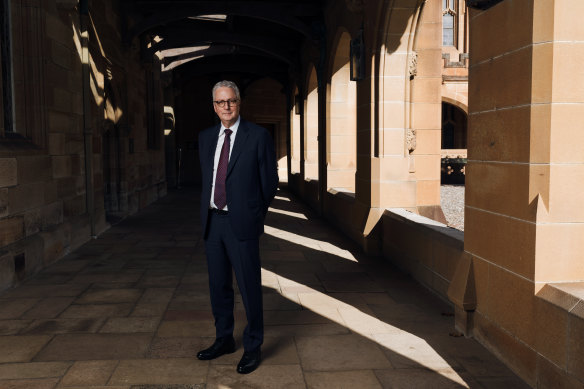By Lucy Carroll and Daniella White
The salaries of four university vice chancellors remain at about $1 million after most tertiary education chiefs’ pay packets fell slightly or held steady during the COVID-19 pandemic, following heavy job losses and the international student market collapse.
The salary figures come as new data shows students at some of NSW’s top universities are among the least satisfied in the country, although the institutions regained some ground lost during the pandemic.

The salary for the top job at Sydney University fell by $500,000 a year for vice chancellor Mark Scott.Credit: James Brickwood
The 2021 Student Experience Survey, commissioned by the federal government and released on Wednesday, revealed the University of NSW was the lowest ranked in the state, with a 66.9 per cent overall positive student approval rating.
But, of the 265,000 domestic students who responded to the survey, 73 per cent were satisfied with their overall educational experience, up from 69 per cent in 2020.
“The student educational experience has changed appreciably since 2019 as institutions have adapted in response to the COVID-19 pandemic,” the survey said.
Professor Andrew Norton, a higher education academic at the Australian National University, said some vice chancellors took pay cuts during COVID as universities shed thousands of jobs, and “internal politics dictated university leaders had to participate in the pain”.
Salaries of the highest-paid university heads have shrunk since 2020, with the top job at Sydney University falling by about $500,000 when vice chancellor Mark Scott began in July 2021. The Herald has previously reported he will earn a maximum of $1.15 million including bonuses. Scott’s predecessor, Dr Michael Spence, left in 2020 on a salary of about $1.6 million.
“Vice chancellors have an extremely tough job, but $1 million-plus pay is in excess of the prime minister and departmental secretaries who have equally high pressured and demanding jobs,” Norton said. “It’s one of the drivers of resentment. There has been no major change over a number of years.”
Vice chancellors’ salaries have come under attack in recent years, and the University Chancellors Council last year unveiled a voluntary code that would benchmark the salaries of university vice chancellors against top public servants in a bid to make their pay packets more transparent.
Analysis by Macquarie University accounting professor James Guthrie and data collected from the universities found vice chancellors at the University of NSW, Macquarie University, Western Sydney University and the University of Sydney topped the list, with salaries nearing or more than $1 million.
A UNSW spokesperson said the total remuneration for new vice chancellor Attila Brungs was $1.05 million, including salary and superannuation, which is below the $1.3 million salary of former vice chancellor Ian Jacobs.
At the University of Wollongong, vice chancellor Patricia Davidson earns a salary of $610,000, below her predecessor’s remuneration in 2020 of about $980,000. At the Australian Catholic University, vice chancellor Zlatko Skrbis’ salary is $1.09 million, a 20 per cent drop on 2019 figures. And at Macquarie University, vice chancellor Bruce Dowton has a salary of $1.06 million, about 3 per cent down on his 2019 pay packet.
But Guthrie said greater transparency was needed in annual reports on vice chancellors’ salaries, especially because, in the private sector, listed companies must disclose the total amount paid to chief executives.
“The current annual reports do not provide sufficient performance information about exact salaries, and we can’t judge how senior staff and the vice chancellor are performing or if they are meeting objectives,” he said.
He said the analysis shows it is impossible to determine actual vice chancellor remunerations from annual reports and that, in the UK, an annual survey of vice chancellors’ pay is undertaken.
The Student Experience Survey attributed the improved ratings across most of the country’s universities in part to a return to on-campus learning.
Nationally, 73 per cent of university students rated their overall experience positive in 2021, up from 68.4 per cent in 2020.
It was still well below the positive scores of between 78 and 80 per cent that were consistently recorded in all pre-pandemic surveys.
“This suggests that, while institutions have been able to respond and adapt to some extent to the changed teaching and learning environment, challenges remain while on-campus learning and extracurricular activities continue to be curtailed due to the COVID-19 pandemic,” the survey read.
Six NSW universities – UNSW, Western Sydney University, University of Technology Sydney, the University of Sydney, the University of Wollongong and the University of Newcastle – scored below the national average, but all improved on their 2020 scores.
The 2021 results showed positive ratings increased more for younger students, up 5 percentage points for those under 25, which was partly attributed to some return to on-campus learning.
Local students reported a significantly higher positive rating than international students, at 74 per cent compared with 67 per cent respectively.
Federal Education Minister Jason Clare said the survey showed student experience was starting to improve but there was more work to be done.
“The worst of COVID is hopefully behind us, but its impact on students is still here and you can see it in the data,” he said.
“Students’ lives have been turned upside down by the pandemic. One day they were in the classroom with friends, the next they were in their bedroom on Zoom.”
The Morning Edition newsletter is our guide to the day’s most important and interesting stories, analysis and insights. Sign up here.